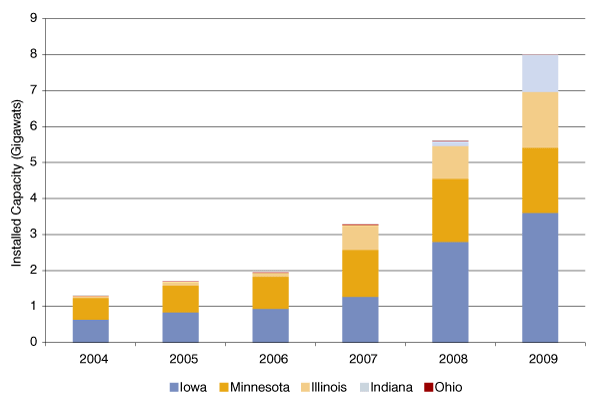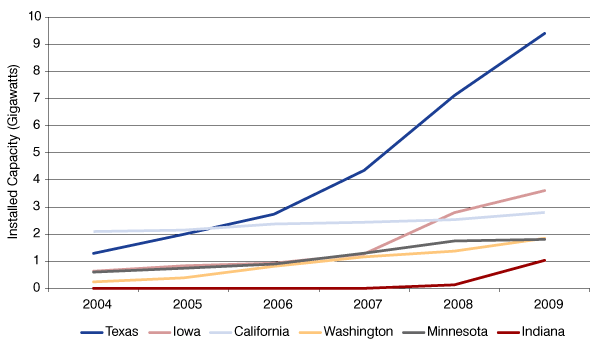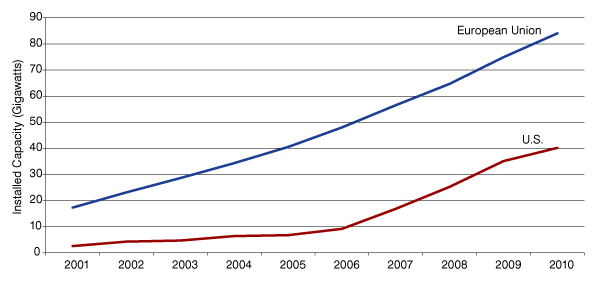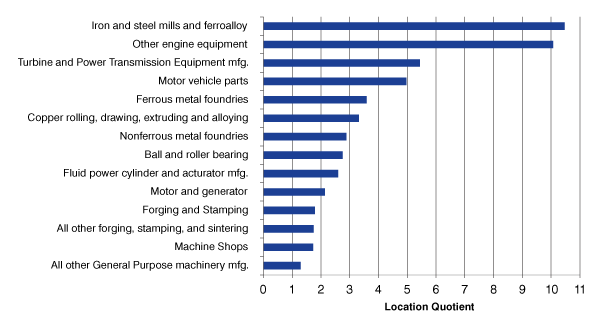Who Builds Those Windmills?
The windmill has become a symbol of Indiana’s move into the clean energy future. Many Hoosiers have gazed in awe at the expansive wind farms off of I-65 just north of Lafayette. But how much do we really know about wind energy in Indiana?
In the last several decades, wind energy has come a long way from the heavily subsidized Carter-era energy projects that eventually fizzled. Recently, thanks to technological developments making turbines more efficient, wind energy has taken off in the United States. Installed capacity for wind energy in the U.S. has increased at an average rate of 22 percent over the past five years.
The Midwest has experienced similar growth in wind energy capacity. Iowa and Minnesota have led the expansion in the Midwest over the last five years, complemented more recently by Indiana (see Figure 1). As Figure 2 shows, Iowa and Minnesota are two of the top five wind-producing states across the nation as a whole due largely to their favorable wind conditions.
Figure 1: Installed Capacity for Select Midwest States, 2004-2009

Source: U.S. Department of Energy
Figure 2: Wind Energy Production: Five Largest States and Indiana, 2004-2009

Source: U.S. Department of Energy
The U.S. has put up some impressive growth numbers, but it has a long way to go to equal the wind energy produced in the European Union (EU). As Figure 3 shows, U.S. installed capacity is about half that of the EU. The EU derives about 3.5 percent of its energy from wind, compared to the U.S. at less than 1.5 percent. Considering that wind power is such a small share of electricity generation, the U.S. Department of Energy’s goal to produce 20 percent of all America’s electricity from renewable sources by 2030 is a daunting target. With that said, the U.S. wind energy sector is expanding rapidly, and Indiana and the greater Midwest not only stand to gain from wind as a source of energy, but also from windmill manufacturing as a source of economic growth.
Figure 3: Power Generation from Wind, 2001-2010

Source: Global Wind Energy Council
Indiana Wind Farms
Indiana is currently home to four industrial wind farms in Benton and White counties. Three are entirely European owned, while the Fowler Ridge wind farm is a joint venture between a West Virginian company and BP (see Table 1).
Table 1: Indiana's Wind Farms, November 2010
| Wind Farm | Power Generating Capacity (Megawatts) | Number of Wind Turbines | Owner |
|---|---|---|---|
| Fowler Ridge | 600 | 355 | BP Alternative Energy (U.K.) and Dominion (West Virginia) |
| Hoosier Wind Project | 106 | 53 | Électricité de France |
| Meadow Lake Wind I,II & III | 501.2 | 303 | Energías de Portugal |
| Goodland Wind Plant I | 131 | 87 | BP Alternative Energy (U.K.) |
Source: Indiana Office of Energy Development
The Department of Energy estimates that the construction of Indiana’s wind farms employed around 2,000 people. Once operational, however, the employment figure declines to about 85 maintenance and repair workers.1 Wind power generation is not going to create many jobs in the long term. However, wind turbine manufacturing does offer great potential for employment growth.
Turbine Manufacturing
Wind turbines consist of five components: the blades, the tower, the gearbox, the generator and the nacelle (which is the housing that surrounds the generator, gearbox and other electronic systems).
The blades and the towers do not travel well due to their size, and bridge clearances limit transportation options. As a result, blade and tower manufacturers prioritize the proximity of intended wind farms on the availability of transportation links when locating a plant.2 However, occasionally the larger components will be imported. For example, 75 wind turbine blades (at lengths of nearly 54 yards a piece) were recently imported from Denmark via the Port of Indiana at Burns Harbor for Horizon Wind’s new Timber Road wind farm in Payne, Ohio.3
Manufacturing other windmill components also offers potential for economic growth and job creation in the Midwest if the predominantly European manufacturers shift production from Europe and Asia. There is already evidence that this is occurring: the past six years have seen European wind energy firms announce a total of $1.7 billion of foreign direct investment in the United States. The largest investor is Vestas Wind Systems, committing to spend over $1.3 billion, or more than 80 percent of total wind investment from European firms. Investments have primarily been in manufacturing (see Table 2).
Table 2: Manufacturing Investments over $50 Million by European Wind Energy Firms in the United States, 2004-2010
| Company | Total Investment | Total Jobs | Origin Country | Destination | Year Announced |
|---|---|---|---|---|---|
| Vestas Wind Systems | $498,600,000 | 1,600 | Denmark | Colorado | 2010 |
| Vestas Wind Systems | $240,000,000 | 550 | Denmark | Colorado | 2008 |
| Siemens | $200,000,000 | 300 | Germany | North Carolina | 2004 |
| Vestas Wind Systems | $180,000,000 | 650 | Denmark | Colorado | 2008 |
| Vestas Wind Systems | $111,700,000 | 255 | Denmark | Colorado | 2008 |
| Nordex | $100,000,000 | 700 | Germany | Arkansas | 2008 |
| Vestas Wind Systems | $72,700,000 | 240 | Denmark | Colorado | 2010 |
| Vestas Wind Systems | $61,500,000 | 400 | Denmark | Colorado | 2007 |
Source: FDI Markets
Many smaller windmill components are manufactured within the European Union and then exported to the United States. Brevini—one the largest manufacturers of speed changers, drivers and gears, all of which are regularly used in the construction of windmills—is bucking this trend with their investment in Indiana. In 2008, Brevini, an Italian company with U.S. operations headquartered in Indiana, announced that it intended to invest $86 million at its existing site just outside of Muncie. The construction funded by this investment is still ongoing and is expected to produce over 400 jobs when complete.
Researchers at Illinois State University have identified a variety of industries that contribute to wind turbine manufacturing, including machine shops, rolled steel manufacturers and electronics manufacturers. The Midwest, and Indiana in particular, has a particularly high concentration of iron and steel mills and other engine manufacturing firms, both of which are vital to the production of wind turbines. Figure 4 demonstrates that there are high concentrations of employment in ductile iron castings and gearing and bearing manufacturing compared to the national average. (In this figure, a score of one represents an equal concentration to the national average.) As Figure 4 indicates, the concentration of employment in iron and steel mills, as well as other engine manufacturers, in Indiana is more than 10 times the U.S. concentration. If recent trends continue and the U.S. makes progress toward the goal of deriving 20 percent of its power from renewable energy by 2030, the demand for wind turbines and the workers who build them is sure to increase in the next two decades.
Figure 4: Location Quotients for Select Indiana Manufacturing Industries, 2010

Source: Bureau of Labor Statistics
There is also an opportunity for homegrown wind energy start-ups to enter this market. Firms like Vela Gear Systems, located in Carmel, Ind., or Renewegy in Oshkosh, Wis., have both successfully established themselves as manufacturers of components specific to the wind power industry. Vela is expecting rapid expansion over the next three years and, thanks in large part to tax credits from the Department of Energy, may grow from one full-time and six part-time employees to more than 160 by 2014. These new firms are not in direct competition with the European manufacturers and instead tend to focus on installations for individual firms or smaller scale wind generation. Nevertheless, start-ups in the Midwest are emerging and finding their niche in this expanding sector.
Wind Turbine Occupations
The wind turbine industries that are relatively concentrated in Indiana employ a variety of production occupations. The iron and steel milling industry, for example, employs many assemblers and fabricators as well as installation, maintenance and repair workers. The turbine and power transmission and other engine manufacturing industries hire assemblers, fabricators, metal and plastic workers in addition to mechanical and electrical engineers, engineering technicians, and drafters. Based on just the top three industries that both supply windmill components and in which Indiana (and the Midwest) have relative strengths, it appears that the industries supplying windmill components hire across a wide range of educational and skill requirements.
Conclusion
Wind generates just a sliver of the power consumed by Americans, but it is expected to grow rapidly over the next 20 years. The EU is the world leader in wind energy, boasting some of the world’s largest wind power companies, including Siemens, Nordex and Vestas. Midwestern firms entering the windmill or component market will face stiff competition from these companies. Nevertheless, as these EU firms seek to improve the proximity of their operations to the point of installation, Midwestern firms will likely see growing opportunities to carve out their slice of America’s wind power industry.
Notes
- National Renewable Energy Laboratory, NREL's Wind Powering America Team Helps Indiana Develop Wind Resources (Golde, CO: NREL, 2010).
- Andrew S. David, Wind Turbines Industry and Trade Summary (Washington D.C.: United States International Trade Commission, 2009).
- Diane Krieger Spivak, "First Ship en Route to Burns Harbor Port with 75 Wind Turbine Blades, "Post-Tribune,
www.indianaeconomicdigest.net/main.asp?SectionID=31&
SubSectionID=306&ArticleID=59106.
By Indiana Business Research Center Analysts
Indiana University Kelley School of Business
This research was supported by a grant from the European Union.
